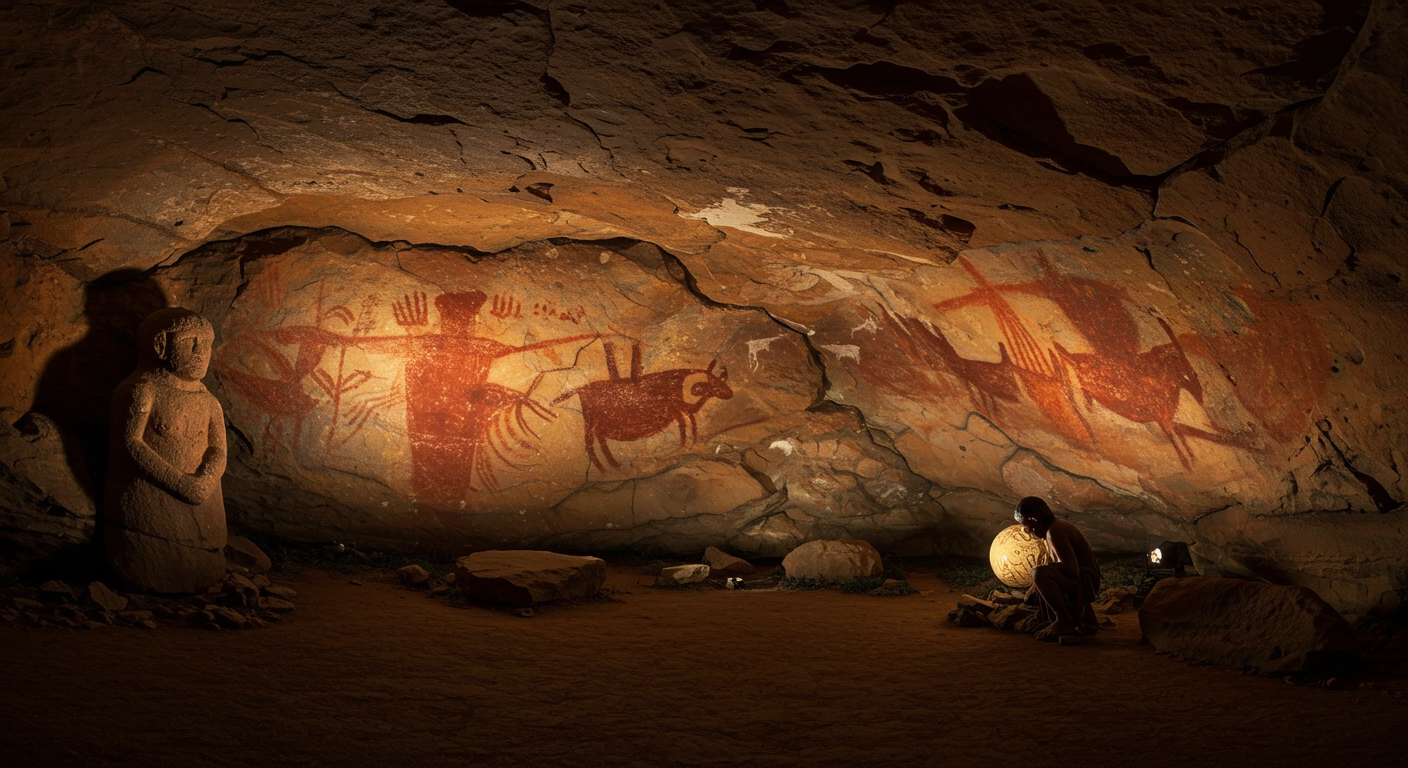Imagine a world without books, without photos, without even writing. How would people share their stories, their beliefs, or their history? They used ancient artz—an early and essential form of visual communication!
What Is Ancient Artz?
This term refers to the incredible creative expressions and visual representations made by early human civilizations. It’s a huge period, stretching from the Upper Paleolithic era, around 40,000 BCE, all the way to the early Middle Ages, which is about 500 to 800 CE, depending on where you were in the world.
More Than Just Decoration
Ancient artz isn’t just about pretty pictures or aesthetic appeal. It covers a vast range of cultures across different continents, and each one left behind a unique artistic legacy. These artworks give us a profound look into the lives, beliefs, and technologies of the people who created them.
Why Ancient Artz Still Matters
Understanding ancient artz is super important. It helps us grasp human history and our shared journey of creativity. It shows us how people communicated, celebrated, and made sense of their world long before modern tools or digital platforms existed.
Why Did They Create Ancient Artz? Purpose and Power
Spiritual and Religious Connections
Many early artworks had a sacred function. They were used in worship, burial practices, and to honor gods, spirits, or ancestors. Think of Egyptian tomb paintings, for example. They often showed gods and scenes from the afterlife, directly reflecting the strong spiritual beliefs of the people who made them. These artistic expressions were like a bridge between the physical world and the world of spirits.
Ceremonial and Ritualistic Uses
Beyond daily worship, ancient artz was also crafted for specific ceremonies or seasonal events. Objects like masks, amulets, idols, and altars were carefully made for rituals, such as fertility rites or funerals. These items were a vital part of the traditions that guided ancient societies and their spiritual experiences.
Storytelling and Historical Records
Ancient artz also served as a visual record. It captured important events, showed how society worked, and celebrated achievements. For instance, petroglyphs (carvings on rock) and other carvings probably acted as an early form of writing, telling stories, or even mapping spiritual journeys. Egyptian wall paintings and hieroglyphics often worked together to tell stories and document historical moments for future generations.
Symbols of Power and Authority
Art was a powerful tool for rulers and religious elites. It was used to praise kings, queens, gods, and goddesses, and to help maintain religious and political order. A famous example is the Code of Hammurabi from ancient Mesopotamia. This artwork features laws carved in stone, topped with an image of King Hammurabi and the god Shabash, showing how art reinforced authority. Statues of pharaohs, often sculpted to look eternally young and perfect, emphasized their divine nature and power.
Everyday Expression and Utilitarian Art
Even everyday items could be works of ancient artz. Things like pottery, tools, and textiles were often decorated with patterns and designs that reflected the local culture. This shows how art wasn’t just for grand temples or tombs; it was a part of daily life, blending usefulness with beautiful artistic form to enrich their routines.
A Journey Through Time: Iconic Civilizations and Their Ancient Artz
The Dawn of Creativity: Prehistoric Ancient Artz
Our journey starts with the very first human artworks. Cave paintings, like those in Lascaux, France, are about 17,000 years old. These mysterious artworks, often found deep inside caves, might have been used for ceremonies or spiritual purposes rooted in early belief systems.
Then there are the Venus Figurines, small statues carved during the Paleolithic era. They often highlighted fertility and early human beliefs. The oldest known evidence of symbolic understanding comes from Blombos Cave in South Africa—carved ochre pieces dating back about 77,000 years!
Eternal Beauty: Egyptian Ancient Artz
Egyptian ancient artz is truly unique and iconic. It’s known for its perfect balance (symmetry), deep meanings (symbolism), and strong connection to the gods and the afterlife.
Think of the massive Pyramids of Giza, the majestic Great Sphinx, and the colorful tomb paintings filled with hieroglyphics. Egyptians believed statues could hold the “ka” (spirit) of gods and pharaohs, so they sculpted them to look ideal and eternal, showing their divine power and importance.
Cradle of Civilization: Mesopotamian Ancient Artz
From the land between two rivers, Mesopotamia, came art that helped shape early societies. The Code of Hammurabi is a famous example, showing how art was used to establish laws and order. We also see impressive ziggurats, towering temple structures that were central to their cities and their spiritual life.
Ideal Forms and Humanism: Greek Ancient Artz
Greek ancient artz celebrated the human form, balance, and harmony. They created iconic works like the Parthenon, famous sculptures, and used frescoes and mosaics in their homes. You might even see “contrapposto,” a cool pose where a figure’s body twists, making it look more natural and lifelike.
Realism and Empire: Roman Ancient Artz
Roman ancient artz was all about showing things realistically, whether it was people or landscapes. They built engineering wonders like the Colosseum and created intricate mosaics and frescoes in places like Pompeii, showing scenes from daily life and mythological stories.
Spirituality and Intricate Detail: Asian Ancient Artz
Asia contributed incredibly rich and detailed ancient artz.
China: Calligraphy was considered a supreme art form, blending beauty with philosophy. They also made intricate bronze work with special “taotie” designs and beautiful jade carvings that symbolized purity. Don’t forget the amazing Terracotta Army!
India: We see stunning Buddhist art, including the famous Ajanta cave murals, that depict spiritual journeys and teachings of the Buddha.
Astronomy, Ritual, and Nature: Pre-Columbian Ancient Artz (Americas)
The Americas also have a rich history of ancient artz. Civilizations like the Olmec (known for huge stone heads and jade masks), Maya (with their unique writing, stone monuments called stelae, and buildings linked to astronomy), and Aztec (famous for featherwork, stone carvings, and codices) created incredible art.
Their art often showed a deep understanding of astronomy and a strong respect for their gods and nature. And did you know that ancient Andean textiles are considered one of the world’s greatest fiber art traditions? Museums even have special galleries just for them!
Crafting History: Materials and Techniques of Ancient Artz
Stone Carving
Stone was a fundamental material. Artists carved monumental statues, practical tools, grand temples, and huge megaliths. Imagine the sheer effort and skill needed to shape stone without today’s machinery—truly a feat of ancient ingenuity.
Cave Painting and Pigments
Early artists used natural pigments from minerals and plants to create stunning artworks deep inside caves. They found ways to apply these colors to rock surfaces, often in very challenging conditions and limited light.
Pottery and Ceramics
Clay was shaped into both useful vessels for everyday life and beautifully decorated objects for ceremonies. The way they made and decorated pottery changed over time, showing their growing skills and cultural shifts.
Metalwork
Ancient artists were also masters of metal. They created intricate bronze work, like ritual vessels with special “taotie” designs, and elaborate jewelry from precious metals like gold. The precision needed for casting and shaping metal was truly impressive and required advanced techniques.
Fresco and Mosaic
These techniques were key for ancient wall and floor art. Frescoes involved painting directly onto wet plaster, often seen in Roman homes like those in Pompeii, showing mythological scenes or daily life.
Mosaics were detailed images made from tiny colored stones and glass, showing off wealth and amazing craftsmanship. “Buon fresco” means “true fresco,” painting on wet plaster while it’s still moist.
Textiles
The art of textiles was highly developed, especially in the ancient Andes. These sophisticated fabrics are considered one of the world’s great fiber arts traditions. The complex weaving and dyeing techniques used to create these durable and symbolic cloths were remarkable.
Art as Writing
Sometimes, visual art and writing were seamlessly combined. Hieroglyphics, a sacred writing system, were often part of Egyptian wall compositions. In Asian cultures, calligraphy was seen as a supreme art form, blending beautiful writing with deep philosophical meaning.
Ancient Artz Today: Its Enduring Legacy and How to Experience It
Why It Still Matters
Even though it was created thousands of years ago, ancient artz still has a powerful impact on our world today.
Ancient artz holds the values, myths, and technologies of early civilizations. It laid the groundwork for much of the religious art, architecture, and visual symbols we see in different cultures even now. The universal human desire to express, to remember, and to go beyond ourselves, which is so clear in ancient artz, still connects with us today.
Modern Echoes
You might be surprised how much ancient themes pop up in modern life! Ideas like love, power, spirituality, and heroism from ancient times still appear in today’s art, buildings, fashion, home decor, and even movies and games.
Think of it this way: the symbolic power of a pharaoh’s statue is a bit like a modern national monument. Or the storytelling in hieroglyphics is similar to how a comic book tells a story. Ancient artz shows us the timeless appeal of these early creations and symbols.
Experiencing Ancient Artz Now
Want to connect with ancient artz yourself? Here are some ways you can experience it:
- Visit Museums: Go to world-famous places like The Metropolitan Museum of Art to see these masterpieces up close. Many museums also offer high-resolution images online, so you can explore art from home at your own pace.
- Explore Historic Sites: Imagine standing where ancient civilizations once thrived! You can visit the majestic Pyramids of Giza, the incredible Parthenon in Athens, the monumental Great Wall of China, or the breathtaking Machu Picchu.
- Incorporate into Your Lifestyle: Have some fun with it! Use ancient patterns and designs in your home decor to add a touch of history. Look for accessories or clothes inspired by ancient styles. You could even try hands-on craft projects like pottery or painting to recreate ancient art forms yourself.
The Timeless Message of Ancient Artz
From the earliest cave paintings to the monumental pyramids, ancient artz reminds us that humans have always shared a universal urge to express, immortalize, and transcend. It’s incredibly diverse in its forms and purposes, and its legacy continues to inspire us across generations and cultures.
What stories will our art tell about us thousands of years from now?

